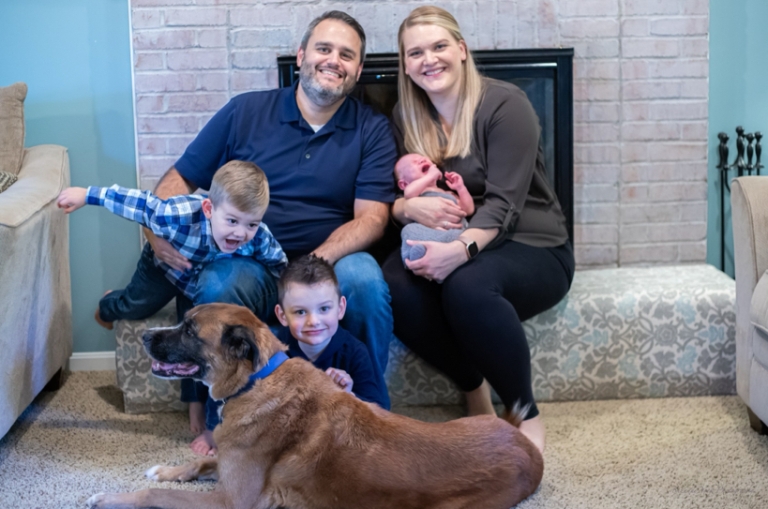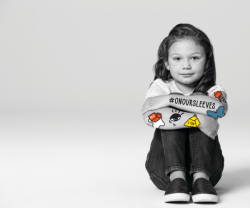11/13/24 blog post
kids grieve too: how to support your child after the loss of a pet
a family shares how they helped their children with grief after losing a pet

Pets are a special part of our families – they give us unconditional love, greet us happily at the door, and comfort us when we’re feeling down. For many children, pets are their first friends. Losing a pet can be especially hard on kids, especially if it’s their first experience with loss.
“Losing a pet is difficult for anyone, but it can be particularly challenging for children, who may feel confused or unsure of how to handle their grief,” says Emily Weitz, a children’s mental health expert.
If you’ve lost your pet to sickness, age, accident, moving or running away, there are ways to help your kid manage the grief. Emily shares some advice for questions you might have.
How can I explain to my child what happened?
When discussing the loss of your pet it’ s important to be honest while keeping the explanation age-appropriate. It might be tempting to soften the truth, but saying a pet “went to sleep” but this can lead to more confusion.
- Be clear and direct. Let them know what happened in a simple way and reassure them that it wasn’t their fault.
- Encourage questions. Let your child know they can ask anything they want. This can help
Is showing my own true feelings helpful?
“Showing your feelings can be incredibly helpful for your child,” shares Emily. “Kids often look to us for guidance on how to react, so if you openly express your grief, it lets them know it’s okay to feel sad, too.”
- Remember that your children are watching you. Trying to act like you aren’t upset may lead them to think something is wrong with them for feeling upset. Instead, normalize being sad when there is a loss.
- Take time for yourself to grieve as well. Let your child watch you process your own grief. This will show them healthy ways to deal with the loss.
How can I help my child deal with the hurt?
Helping children remember the good times they had with their pet can make the grieving process gentler. Here are some ways to honor those memories:
- Create a memory project: Doing an activity to reflect on positive memories of the pet are helpful such as creating a special picture frame for a picture of the pet or creating a collage of pictures.
- Keep a few pet items for a while: Consider leaving out some of the pet’s items. Getting rid of the items right away might make your child feel like the pet didn’t matter and that it is time to move on.
When should I consider getting another pet?
“A new pet can help your family feel better, but you want to make sure your children see this as a new opportunity and not a replacement,” says Emily. Here are some ways to ease into the transition.
- Be thoughtful about when to get another pet. Explain that you can’t replace loved ones but that a new furry friend can also bring joy in a unique way.
- Celebrate differences: Let them know that this pet will not be exactly like the last one. Each pet has its own personality and something special that it brings.
how one family supported each other after pet loss
Jared Hayes, a local dad, recently found ways to help his family through the loss of their beloved family dog, Ernie. "He saw us through getting married, moving into our house, and bringing home 3 kids! He was our constant through all of lives changes as we started our family," shares Jared. After losing Ernie, Jared, who works in behavioral health administration, used these tips to help his children find comfort amidst their grief.
- Creating Memories: We created a photo album of our pet with pictures of him and the boys. This gave them something tangible to look, hold, and even hug to remember him. We put it on our coffee table and then in our cabinet so it was easily accessible to them whenever they were thinking about him.
- Being honest and making decisions together: We had our pet cremated and were honest about his remains and let our boys help decide what to do with the remains. My idea was to bury him in the back yard and have a little ceremony, but the boys wanted to keep him in the house, so he is in our cabinet. I think this was important, so they felt like they had a say and know where he is. We also had several discussions about our perspective on the afterlife with our kids. So be prepared to talk about your religious views and your perspective on the afterlife as that was a big conversation.
- Giving Each other Grace: We allowed everyone to talk about him whenever they needed and reminded ourselves to give each other grace when grieving. We all displayed grief with frustration and anger at times and it was important to remind ourselves what was really the root cause of it.
- Accepting Unexpected Sadness: It’s important to be prepared for the feelings of loss and sadness to manifest at any time, even during unrelated times. We would be somewhere, or the boys would be playing and all of a sudden, they would get upset and sad because they randomly thought about him. Encouraging them to share their feelings and acknowledging that this is hard really helped them.
- Being patient: Be prepared to explain what happened and that the pet is no longer here multiple times in multiple ways. This isn’t one and done conversation. Kids forget or they don’t truly understand so we had to be prepared to talk about it and explain it again whenever they needed.
Unlike adults, children may express grief differently, and it's important to understand that grief can happen for more situations than just the loss of a loved one. Whether they’re grieving the loss of a pet or a loved one, helping kids understand and express their feelings builds resilience and emotional health. By creating a safe space for them to process loss, we teach children that it’s okay to feel sad and that they’re not alone in their grief.
more resources for children's mental health
Understanding grief and loss is an important part of a child's mental health. If you're interested in exploring more about supporting a child through grief, read our blog with expert tips and free resources. And, if you're interested in learning more expert tips on how to break the stigma around children's mental health, we want to invite you to join the On Our Sleeves e-community!
Our mission is to get our free, expert-created resources to as many caring adults in our communities so that everyone can understand and promote mental health for children.
Join us on this mission, by clicking the orange button below! You'll be signed up to start receiving monthly free content and resources to help you support the mental wellness of children in your life and break the stigma surrounding mental health. You'll also be the first to know about special giveaways like our Emotion Explorers Activity Book and Conversation Starter Cards!





